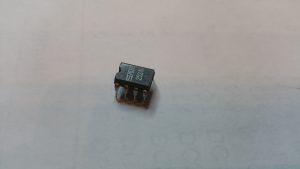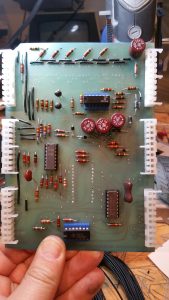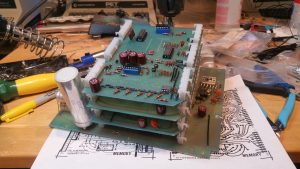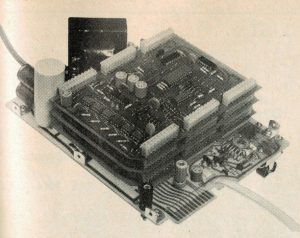Things are rolling along smoothly on my TV Typewriter build. At last, I have reached the summit of this device – the Memory board. This is the board – easily the most intricate and complex, and important.
The Memory board is where the magic happens. It is host to the Signetics 2513 character generator ROM:
Chances are if you had any involvement with 8 bit computing back in the day, you’ve had or used this ROM. It was used in the Apple I, the Apple II, the SWTPC CT-1024, early Atari games and so on for generating (upper case) text. In fact, if you’re typing on an original Apple II, you’re producing exactly the same characters this TVT device does.
The memory board also hosts the all important ‘memory’, in the form of 6 Signetics 2524v shift registers.
These tiny (and rare) 8 pin chips can each handle 512 bits of information. If my calculations are correct, 6 of them together produces the equivalent of about 384 bytes of memory. Oooooooh!
Now, the TVT was a modular design, so you could add additional ‘pages’ of memory to handle more. But to get to just 1KB you’d need three of these things, and because my prototype case is only about 4.5″ tall, it wouldn’t fit. So I’m sticking with just the one – that’s good enough for a full page of characters. Plus, it’s not like Page B will do you much good. The two pages do not exist seamlessly for the user – ie, you can’t just type two pages worth of data on the screen, scrolling down as you go. You have to manually flip a switch to go between pages. When you reach the bottom of either page, the whole thing blanks and begins fresh. Anything you typed before is gone! As a terminal, this is pretty useless. Don was questioned back in the day on the design by Lee Felsenstein, and his response was essentially ‘hey buddy, it’s for putting words on a TV screen!’.
And at any rate, supposing you did make use of both pages, dutifully typing out your 2 page essay on your TVT. You had no way to back it up, unless you knew how to wire up a cassette recorder. Or here’s another recommended method from the article:
LOL
Well, I guess technically it is a hard copy..
Again, Don Lancaster’s TV Typewriter is not an entirely practical device out of the box, really. It was about the concept. Further development was up to you (or him), depending on who got to it first.
Anyway, the Page A board is distinct from any subsequent boards you build – Page B etc don’t need to have their own character generator or associated circuitry, so a whole bunch of resistors, etc are left out. But for Page A, it’s all on, and this board is a blizzard of ICs, resistors, diodes, caps and my least favourite thing in the universe next to mint-flavoured-anything: jumper wires. Lots. And lots. (And lots). Lots of jumper wires. You need to be in a Zen mode to handle that.
And you need to pay very close attention. Because the traces are tightly packed, there’s a lot of holes, and it’s easy enough to accidentally bridge something with solder or install into the wrong holes. Definitely do not do this while tired!
The drilling was the worst though – it took me about an hour with a Dremel to get it all and even my poor eyes, which were crossing, missed a couple. And let me tell you about drilling PCBs: it stinks. Do not do this in a small room. You should also wear a respirator. Drilling PCBs produces a nasty, smelly, very fine glass dust. It’ll stink up your room for an hour. Trust me. Do this in a garage.
Anyway, after that and about about five hours of soldering, here’s what we have so far:
Looking pretty good! I received and am using those little Bakelite 100uf caps. They definitely look period correct! I’m also mixing and matching the other IC sockets as I suspect any hobbyist/prototype maker reaching into his parts bin would have back in the day.
I am waiting for a correct-looking 24 pin socket for the character generator and some blue 8 pin sockets I found for the shift registers to finish that end of it off. In the meantime, I’ll Zen-out and install jumpers everywhere else it’s needed.
Regarding connecting all four boards together, I’m relieved to report that they all can be snapped together, with a fair bit of finagling. In this pic I haven’t pressed them in all the way – I really hate Molex connectors and the amount of force required to install or separate things with them. It flexes the hell out of the boards and makes me cringe every time. I’m amazed the pins are breaking off!
Anyway, here’s a beauty shot. Beneath it is a shot of Don’s original. We’re getting there!





